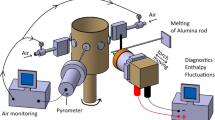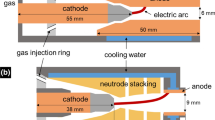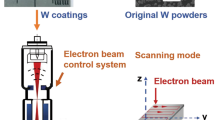Abstract
Tungsten-based coatings have potential application in the plasma-facing components in future nuclear fusion reactors. By the combination of refractory tungsten with highly thermal conducting copper, or steel as a construction material, functionally graded coatings can be easily obtained by plasma spraying, and may result in the development of a material with favorable properties. During plasma spraying of these materials in the open atmosphere, oxidation is an important issue, which could have adverse effects on their properties. Among the means to control it is the application of inert gas shrouding, which forms the subject of this study and represents a lower-cost alternative to vacuum or low-pressure plasma spraying, potentially applicable also for spraying of large surfaces or spacious components. It is a continuation of recent studies focused on the effects of various parameters of the hybrid water-argon torch on the in-flight behavior of copper and tungsten powders and the resultant coatings. In the current study, argon shrouding with various configurations of the shroud was applied. The effects of torch parameters, such as power and argon flow rate, and powder morphology were also investigated. Their influence on the particle in-flight behavior as well as the structure, composition and properties of the coatings were quantified. With the help of auxiliary calculations, the mass changes of the powder particles, associated with oxidation and evaporation, were assessed.













Similar content being viewed by others
Notes
It is worth noting that the water-stabilized plasma itself is a reducing environment, since there are two hydrogen species for each oxygen in H2O molecules dissociated during plasma generation. However, plasma jets generated by this type of torch are characterized by strong entrainment of ambient air, which is the main factor in the in-flight oxidation.
While 300 A was previously found optimal for spraying of copper and 500 A for tungsten, intermediate settings were also investigated for the sake of potential composite formation.
References
J. Matějíček, P. Chráska, and J. Linke, Thermal Spray Coatings for Fusion Applications—Review, J. Therm. Spray Technol., 2007, 16(1), p 64-83
J. Matějíček, Y. Koza, and V. Weinzettl, Plasma Sprayed Tungsten-Based Coatings and Their Performance Under Fusion Relevant Conditions, Fus. Eng. Des., 2005, 75-9, p 395-399
J. Matějíček, and R. Mušálek, Processing and properties of plasma sprayed W + Cu composites, Thermal Spray Crossing Borders (Proc. Intl. Thermal Spray Conf.), E. Lugscheider, Ed., DVS Verlag, Maastricht, 2008, p 1412-1417
M. Vilémová, J. Matějíček, R. Mušálek, and J. Nohava, Application of Structure-Based Models of Mechanical and Thermal Properties on Plasma Sprayed Coatings, J. Therm. Spray Technol., 2012, 21(3-4), p 372-382
H.K. Kang and S.B. Kang, Behavior of Porosity and Copper Oxidation in W/Cu Composite Produced by Plasma Spray, J. Therm. Spray Technol., 2004, 13(2), p 223-228
D. Kolman and K. Voleník, Modeling of Oxidation During Plasma Spraying of Iron Particles, Plasma Chem. Plasma Process., 2002, 22(3), p 437-450
G. Espie, A. Denoirjean, P. Fauchais, J.C. Labbe, J. Dubsky, O. Schneeweiss, and K. Volenik, In-Flight Oxidation of Iron Particles Sprayed Using Gas and Water Stabilized Plasma Torch, Surf. Coat. Technol., 2005, 195(1), p 17-28
T. Kavka, J. Matějíček, P. Ctibor, A. Mašláni, and M. Hrabovský, Plasma Spraying of Copper by Hybrid Water-Gas Dc Arc Plasma Torch, J. Therm. Spray Technol., 2011, 20(4), p 760-774
K. Murakami, N. Fujita, S. Adachi, H. Nakajima, and H. Miyake, Oxidation of Thermal Sprayed Metallic Materials During Flying in Air and the Coating Structures, Mater. Sci. Forum, 2004, 449-4, p 1301-1304
A.A. Syed, A. Denoirjean, P. Denoirjean, J.C. Labbe, and P. Fauchais, In-Flight Oxidation of Stainless Steel Particles in Plasma Spraying, J. Therm. Spray Technol., 2005, 14(1), p 117-124
A.A. Syed, A. Denoirjean, P. Fauchais, and J.C. Labbe, On the Oxidation of Stainless Steel Particles in the Plasma Jet, Surf. Coat. Technol., 2006, 200(14-15), p 4368-4382
C.J. Li and W.Y. Li, Effect of Sprayed Powder Particle Size on the Oxidation Behavior of MCrAlY Materials During High Velocity Oxygen-Fuel Deposition, Surf. Coat. Technol., 2003, 162(1), p 31-41
V.V. Sobolev and J.M. Guilemany, Oxidation of Coatings in Thermal Spraying, Mater. Lett., 1998, 37(4-5), p 231-235
J. Matějíček, K. Neufuss, D. Kolman, O. Chumak, and V. Brožek, Development and Properties of Tungsten-Based Coatings Sprayed by WSP(R), Thermal Spray Connects: Explore Its Surfacing Potential! (Proc. International Thermal Spray Conference), E. Lugscheider, Ed., DVS, Basel, 2005, p 634-640
W.Y. Li, C.J. Li, and H.L. Liao, Significant Influence of Particle Surface Oxidation on Deposition Efficiency, Interface Microstructure and Adhesive Strength of Cold-Sprayed Copper Coatings, Appl. Surf. Sci., 2010, 256(16), p 4953-4958
D.Y. Hu, X.B. Zheng, Y.R. Niu, H. Ji, F.L. Chong, and J.L. Chen, Effect of Oxidation Behavior on the Mechanical and Thermal Properties of Plasma Sprayed Tungsten Coatings, J. Therm. Spray Technol., 2008, 17(3), p 377-384
S. Boire-Lavigne, C. Moreau, and R.G. Saint-Jacques, The Relationship Between the Microstructure and Thermal-Diffusivity of Plasma-Sprayed Tungsten Coatings, J. Therm. Spray Technol., 1995, 4(3), p 261-267
W.J. Lenling, J.A. Henfling, and M.F. Smith, Method for Minimizing Decarburization and Other High Temperature Oxygen Reactions in a Plasma Sprayed Material, Patent US5217746, 1993
J. Matějíček, V. Weinzettl, E. Dufková, V. Piffl, and V. Peřina, Plasma Sprayed Tungsten-based Coatings and their Usage in Edge Plasma Region of Tokamaks, Acta Technica CSAV, 2006, 51(2), p 179-191
T. Kavka, J. Matějíček, P. Ctibor, and M. Hrabovský, Spraying of Metallic Powders by Hybrid Gas/Water Torch and the Effects of Inert Gas Shrouding, J. Therm. Spray Technol., 2012, 21(3-4), p 695-705
G. Mauer, R. Vassen, and D. Stover, Controlling the Oxygen Contents in Vacuum Plasma Sprayed Metal Alloy Coatings, Surf. Coat. Technol., 2007, 201(8), p 4796-4799
M. Jankovic, J. Mostaghimi, and V. Pershin, Design of a New Nozzle for Direct Current Plasma Guns with Improved Spraying Parameters, J. Therm. Spray Technol., 2000, 9(1), p 114-120
K. Neufuss, V. Brožek, and J. Matějíček, Tungsten-based Protective Coating and Method of its Preparation (in Czech), Patent CZ303411, 2012
T. Kavka, J. Gregor, O. Chumak, and M. Hrabovský, Effect of Arc Power and Gas Flow Rate on Properties of Plasma Jet Under Reduced Pressures, Czech J. Phys., 2004, 54, p C753-C758
A. Jillavenkatesa, L. H. Lum, and S. Dapkunas, NIST Recommended Practice Guide: Particle Size Characterization, NIST SP-960-1, 2001
ImageJ, National Institute of Health, http://rsb.info.nih.gov/ij/
R. Mušálek, J. Matějíček, M. Vilémová, and O. Kovářík, Non-Linear Mechanical Behavior of Plasma Sprayed Alumina Under Mechanical and Thermal Loading, J. Therm. Spray Technol., 2010, 19(1-2), p 422-428
F.O. Bartz, D.R. Guildenbecher, R. Schmehl, R. Koch, H.-J. Bauer, and P.E. Sojka, Model Comparison for Single Droplet Fragmentation Under Varying Accelerations, 24th European Conference on Liquid Atomization and Spray Systems, Estoril, Portugal, 2011
L.-P. Hsiang, and G.M. Faeth, Drop Deformation and Breakup Due to Shock Wave and Steady Disturbances, 32th Aerospace Sciences Meeting and Exhibit, American institute for Aeronautics and Astronautics, Reno, NV, 1994, paper no. 94-0560
T. Aoyama, Y. Hattori, J. Mizuta, and Y. Sato, An Experimental Study on Premixed-Charge Compression Ignition Gasoline Engine, SAE Technical Paper 960081, 1996
T. Matsumoto, H. Fujii, T. Ueda, M. Kamai, and K. Nogi, Measurement of Surface Tension of Molten Copper Using the Free-Fall Oscillating Drop Method, Meas. Sci. Technol., 2005, 16(2), p 432-437
M. Hrabovský, V. Kopecký, V. Sember, T. Kavka, O. Chumak, and M. Konrád, Properties of Hybrid Water/Gas DC Arc Plasma Torch, IEEE Trans. Plasma Sci., 2006, 34(4), p 1566-1575
Acknowledgments
Financial support received through grants no. FR-TI2/702 (Czech Ministry of Industry and Trade) and no. TA01010300 (the Technology Agency of the Czech Republic) is gratefully acknowledged.
Author information
Authors and Affiliations
Corresponding author
Appendix: Assessment of Particle Fragmentation
Appendix: Assessment of Particle Fragmentation
According to studies on the behavior of droplets injected inside a cross-flow jet (Ref 28, 29), the key parameters which affect the deformation and fragmentation mechanisms are summarized in two nondimensional numbers: Weber (We), and Ohnesorge (Oh) numbers (Ref 28). Weber number is a measure of the relative importance of the fluid’s inertia compared with its surface tension and in this case gives an idea of the interaction between fluid and liquid droplet; Ohnesorge number relates the viscous forces to inertial and surface tension forces and represents the simplicity to break the droplet into smaller ones. The definitions are shown below:
where \( \rho_{\text{g}} \) = plasma density, \( \nu_{\text{rel}} \) = relative velocity, \( D_{0} \) = droplet initial diameter, \( \sigma_{\text{d}} \) = droplet surface tension, \( \rho_{\text{d}} \) = droplet density, \( \mu_{\text{d}} \) = droplet dynamic viscosity
Once the variables affecting the phenomenon are defined, critical values for deformation and fragmentation should be identified. According to Ref 29, it appears that for low viscosities of the liquid phase (that means values of Oh < 0.1) the liquid droplet does not behave as a sphere when We > 0.6. Furthermore, fragmentation happens when We ≥ 12. Different break-up mechanisms and corresponding We values were presented in Ref 30. If the liquid phase has higher viscosity, resulting in a higher value of the Ohnesorge number Oh > 0.1, the conditions to reach deformation and fragmentation of a droplet are more difficult and the Weber number should then be much higher to reach them.
In order to calculate the parameters presented above, thermodynamic values relevant for the current plasma spraying conditions are needed:
-
torch-related parameters: arc current and Ar flow rate, which affect the plasma jet velocity, temperature, density and other physical properties;
-
parameters of the spraying setup: feeding distance, distance (from torch exit) in which approximately copper particles melt;
-
feedstock-related parameters: copper particles velocity and size distribution (at injection and melting distances).
Since all these data were not available exactly, for evident experimental limits, some approximation had to be made, with the best estimation of values and using the safety overestimating principle. The following parameters were considered:
Among all conditions used in the spraying, only the one with arc current I = 500 A was considered because it is the one which gives the highest amount of energy to the plasma jet, so if deformation and fragmentation do not happen in this case, they will not happen with lower energies. The Ar gas flow rate taken for calculations was 36 L/min (the highest value of the experimental conditions), because increasing the amount of argon increases the momentum transferred to the particles/droplets, so if droplets do not fragment in these conditions, they will not fragment at weaker conditions. The axial distance used to obtain the values of temperature and velocities of plasma and droplets was set at 120 mm from the torch exit, since the injection was made at 60-90 mm and at 120 mm, the particles were reasonably melted, conserving a relatively high temperature and velocity (if data were not available for this distance, interpolations were made from the available data). The particle size was again slightly overestimated; since at 200 μm, fragmentation would be more likely than at 125 μm. Temperature range of the copper droplet between 1356 and 2576 K was considered. The input data used in the calculations are summarized in Table 4.
Rights and permissions
About this article
Cite this article
Matějíček, J., Kavka, T., Bertolissi, G. et al. The Role of Spraying Parameters and Inert Gas Shrouding in Hybrid Water-Argon Plasma Spraying of Tungsten and Copper for Nuclear Fusion Applications. J Therm Spray Tech 22, 744–755 (2013). https://doi.org/10.1007/s11666-013-9895-x
Received:
Revised:
Published:
Issue Date:
DOI: https://doi.org/10.1007/s11666-013-9895-x




